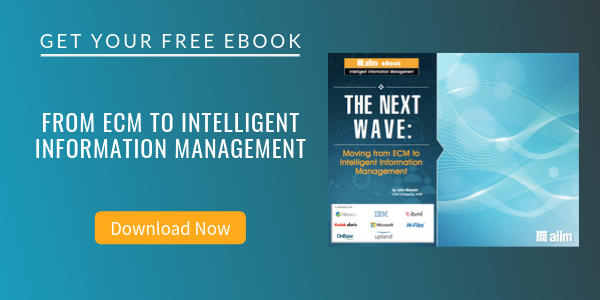
What to Capture Vs. What NOT to Capture
Many organizations have an obligation to maintain the information they create and receive as part of regular business activities and to ensure that the information is secured and maintained in official filing systems. But, with an endless amount of information flowing in and out of your business on a daily basis - how do you determine what to capture and what to avoid?
Not all information is equal, and capturing everything could actually have a more negative impact on your business, but we'll address this later in the post. This post will help you develop an Information Capture strategy that fits your business' needs and avoids the common pitfalls.
What is Information Capture?
Information Capture is the process of getting information (including records) that you have created into some sort of information management system, and recording their existence in the system.
Capture represents the first step in the information lifecycle, and it’s where we can dial in on what should be captured and what should NOT be captured.
Simply put, Capture provides a place for your information stuff. Instead of having your information in separate silos all over the business and essentially unusable, Capture makes it so we know where our information is and can find it and leverage it when needed.

Why Not Capture Everything?
So why shouldn’t organizations simply capture everything - and then keep it forever? This would ensure that everything is accessible and available, right? Well, it's not that easy. In fact, capturing everything actually has the opposite effect. Let's look at the reasons to avoid capturing everything:
- Storage Costs: First, there is the hard cost of storage. It is true that storage is cheaper every day than the day before, but the cost of storage is higher than the simple price for a 1 TB internal hard disk at the local consumer electronics store. It includes the cost to provision and configure the storage, the cost to back it up, and the cost to restore it if it becomes necessary. Moreover, once organizations hit certain levels of storage, the class of storage changes and becomes significantly more expensive.
- Volume Issues: The next reason has to do with the volume of information within the organization. This has ramifications for both operational usage, where users might have to look through ancient invoices to find the one they need, and to respond to legal or audit queries. Consider that this is exacerbated in the digital realm because of the volume of digital information floating about the typical office environment.
- Liability: Finally, the organization could face increased liability for disclosing too much information. For example, in a lawsuit the organization could inadvertently disclose trade secrets, or a government agency could release information that compromises state secrets. For all of these reasons, the smaller the haystack, the more efficient the access.

What to Capture - General Guidelines
Now that we understand why Capture is important and why we need to have strategy in place to be selective on what we capture, let's explore what should be included in our Capture strategy.
For official Records, we capture to ensure that we can maintain that evidentiary weight. Therefore, the key considerations will be around legal, fiscal, operation, and historical requirements of your business.
But, Capture strategies at their core are about saving important and valuable information in a way that you can find it, share it, and utilize it later when needed. Here's some guidelines to consider and questions to ask yourself when capturing information:
- Collaboration - Is this information something that will need to be shared between multiple users? Does it require appropriate control while sharing? Does it require collaboration during creation, after creation, or both?
- Legal Requirements- Is there a legal requirement to capture the information?
- Historical Value - Does this information have historical value to the organization?
- Centralization - Does this information need to be easy to retrieve in the future? Does it need to be managed over its lifetime effectively?
- Manage Appropriately - Does this information need managing? Generally, this applies to official records, but other types of information can also benefit from information management practices.
We should also note that the decision of whether to capture a record or not depends on its content and the value of that content to the organization, NOT on whether it is physical or electronic, or what file format it’s stored in. This is a fundamental tenet of records management: a transaction sent via email holds the same business value as the exact same transaction conducted through Word, or via fax, or by postal mail and the resulting record should be managed according to the same basic principles.
What NOT to Capture – General Guidelines
There are also types of information that probably do NOT need to be captured. Let’s take a look at what to leave out of your Information Capture strategy:
- Redundant – all the multiple copies and versions of a particular piece of information.
- Outdated – information that has been superseded or that has met its business purpose and is no longer needed.
- Trivial – things that are business-related, but barely. Examples might include announcements about minor promotions or organizational anniversaries, or the unofficial “time off tracker”.
- Not Business-Related - Think of all the vacation photos, MP3 files, and all the myriad other types of personal information that probably shouldn’t be stored on organizational servers, but is.
- References and Templates - These need to be managed, generally by being kept until superseded or no longer needed.
These types of information only serve to make the valuable information harder to find and should not be retained at all, or should be destroyed on a regular basis. There are a number of approaches to “clean up” these types of information; we discuss them in more detail here on the blog.
It’s important to note, though, that whether you think a particular type of information has value or not, it should not be destroyed without reviewing with the records management, legal, or compliance function. “Old” information that hasn’t been touched in years could still have a mandatory retention requirement or be on legal hold and getting rid of it can result in significant liability for the organization.
In my next post, we'll take a look at how to best determine if something is a record or not. This is another important topic to consider with your Information Capture strategy and the tips I provide will be helpful in making this distinction.



